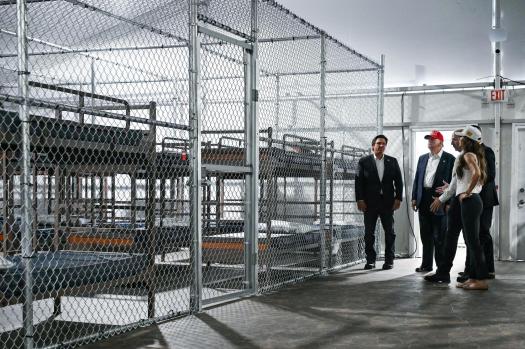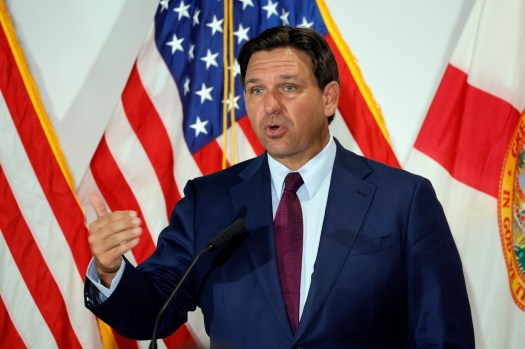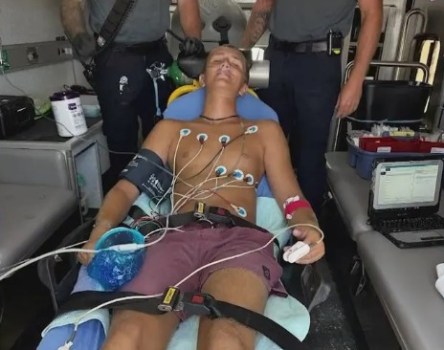Miami Pedro Lorenzo Concepci and dozens of other Cuban nationals were detained at Alligator Alcatraz for a large portion of July in a detention camp that was advertised as a final destination for immigrants who were about to be deported. This was an unsettling situation for someone whose repatriation had already been denied by the Cuban government.
According to his lifelong lover, Daimarys Hernndez, he pleaded with the facility’s administrators to provide some clarification on his fate, but he never heard back. This month, he was finally sent to the Krome detention facility, where he is still awaiting word on his future.
According to documents received by the Miami Herald and Tampa Bay Times, Lorenzo Concepci, 44, is one of hundreds of Cubans who have been detained at the location since the first inmates arrived on July 2. Immigration judges had ordered the removal of about half of them from the United States.
Cuba does not always welcome U.S.-deported individuals, particularly those with criminal histories. As with the two Cubans who recently relocated to war-torn South Sudan, it leaves open the prospect that Lorenzo Concepci, who has previous convictions for marijuana trafficking and credit card fraud, and others like him could be detained forever or sent to distant nations.
In an interview, Hernndez stated that there is a great deal of uncertainty.
The future of Cuban migrants detained in detention facilities around the nation is uncertain.
Cuban immigrants, who for decades had a quicker and easier path to American residency and citizenship than other immigrant communities, are increasingly finding themselves in the crosshairs of immigration officials due to heightened enforcement of immigration laws and increased deportation efforts since President Trump returned to the White House.
South Florida, which for decades welcomed exiles escaping the Castro regime, has arguably seen the most noticeable transformation. Cubans who have just arrived, including those who are applying for refuge, are at risk. A record number of Cuban migrants are fleeing the country as economic conditions deteriorate and political repression rises in tandem with the tougher policing.
Because of Havana’s stringent requirements for accepting returnees and concerns that the Cuban government would persecute them once they return, the United States has typically restricted deportations to Cuba. The Trump administration is actively deporting Cubans to nations like Mexico, where they have no legal status and are not shielded from exploitation and violence, in order to circumvent that difficulty.
According to Ana Sofia Pelaez of the advocacy organization Miami Freedom Project, it’s devastating. The way Americans, particularly some congressmen, discuss Cubans leaving the island and how they are currently handled in the US are not consistent.
About 200 Cubans were held at the Everglades facility at the end of July, according to records examined by the Herald/Times. Only 50 Cubans were left on Wednesday, according to the Department of Homeland Security, but the exact number varies as inmates are moved in and out of the location.
“ICE is targeting the worst of the worst, including terrorists and pedophiles,” stated Tricia McLaughlin, assistant secretary for public relations at the Department of Homeland Security.
She claimed that the reason Cuba does not want to take in deportees is because they are savage criminals.
According to a Herald study of ICE data acquired by the Deportation Data Project at the University of California, Berkeley, since he entered office, U.S. Immigration and Customs Enforcement has nearly increased the amount of detainers issued against Cuban migrants each month.
According to the data, on average, ICE detained 150 undocumented Cuban migrants every month in 2024. By 2025, that number had skyrocketed to almost 500. About 600 Cubans were detained by ICE in May, and over 1,000 in June.
Since the data is probably not complete and the actual number of Cubans being targeted by immigration authorities is probably larger, these numbers are most likely undercounts.
As part of ICE’s well-publicized enforcement efforts in immigration courts nationwide, the Herald has also seen the agency take up Cubans with outstanding asylum and residency cases following their hearings.
According to Miami immigration lawyer Wilfredo O. Allen, who has practiced immigration law for more than 40 years, he has never seen a Cuban who was applying for asylum appear in court and be kept there. This has never occurred before.
Following the Cuban Revolution in 1959, there was an increase in Cuban immigration to the United States. In the decades that followed, waves of immigrants landed in Florida. The newly arrived exiles have an accelerated path to U.S. residency according to the 1967 Cuban Adjustment Act.
Around 120,000 Cubans arrived in South Florida during the Mariel Boatlift in 1980, which marked a turning point for both the Cuban diaspora and U.S. immigration policy.
The Carter administration responded to this large departure by announcing the Cuban-Haitian Entrant Program that same year, which gave those who arrived during this exodus special status. In contrast to the majority of other immigrant groups, their status entitles them to the same benefits as refugees, including SNAP and additional Social Security income.
Over the past ten years, Cuban immigration laws have become more stringent.
Wet foot, dry foot, a decades-old policy that largely permitted Cubans who arrived in the United States to remain, was abolished by President Barack Obama.
According to South Florida immigration lawyers, the way officials handled Cubans when they crossed the U.S.-Mexico border in recent years has made it more difficult for tens of thousands of them to obtain residency under current law.
Additionally, in March, the Trump Administration terminated the humanitarian parole program that allowed more than 200,000 Cubans to lawfully enter the US during the Biden administration. They might be arrested and deported, and their immigration status is now in jeopardy.
Overwhelmed local and federal officials guided individuals who had no prior ties to the United States to temporary tent communities beneath the I-95 overpass along the Miami River when Castro opened the Port of Mariel to escaping Cubans forty years ago. Despite their chaos, the locations served as symbols of safety and hope.
Pedro Lorenzo Concepci and other Cuban migrants are currently being transported under guard to Alligator Alcatraz, another tent community.
The detention camp has been characterized by lawyers and inmates’ relatives as a location where migrants are kept in limbo in filthy and terrible conditions with limited access to legal assistance.
Among them was Lorenzo Concepci, who escaped Cuba almost twenty years ago and is now the father of three children born in the United States, two of which are his biological sons, according to his partner. During a routine check-in at ICE’s Miramar office in early July, he was taken into custody. His companion informed the Herald that he went a week without eating in protest after his attempts to obtain some information about his future failed.
The DHS spokesperson, McLaughlin, rejected Lorenzo Concepci’s account of a hunger strike as fabrications by a felon. The welfare of people under its custody is a primary concern during a hunger strike, she continued, adding that ICE continues to provide three meals a day, delivered to the detained alien’s room, along with a sufficient supply of drinking water or other liquids.
Reports of hunger strikes were also refuted by the office of Governor Ron DeSantis, whose administration is in charge of the facility’s management. When the Herald asked it about the situation of the Cubans, it didn’t answer.
Last week, Lorenzo Concepci was moved from Alligator Alcatraz to Miami’s Krome correctional facility. What will happen next is still not entirely clear.
His partner, Hernndez, told the Herald on Monday that they are still waiting to see what will happen.
While Cuba typically accepts one deportation flight from the United States each month, the country is very selective about the returnees it lets back in, often refusing to take back those with criminal convictions.
With convictions on his record, Lorenzo Concepci n knew he was at risk of being deported. ICE had already tried to expel him once before. But Cuba, Hern ndez said, would not take him back and he has remained in the United States.
American immigration officials are increasingly transferring such immigrants to a third country. To avoid being sent to one, migrants must prove that they would be harmed in such a place a difficult legal burden.
The longer Lorenzo Concepci n goes without answers regarding his status and the outcome of his case, the more terrified he becomes about being sent to an unfamiliar nation, his partner told the Herald.
Allen, the immigration attorney, said he has Cuban clients who have been dropped off at Mexico, where they have no legal status and often no support system.
They were put on a bus, taken across the border and it was like Hey, get out and get lost, he said.
Lawyers like him are concerned that their clients, particularly those from Cuba, Venezuela, Haiti, and Nicaragua, who are deported to nations where they were not born and are not citizens, may lose the majority of their rights and protections for the rest of their lives, become stateless, and become stuck in immigration limbo.
I don t think this [U.S.] government has any worries about that, Allen said. Once a third country accepts them, the United States could care less.
2025 Miami Herald. Visit at miamiherald.com. Tribune Content Agency, LLC is the distributor.












